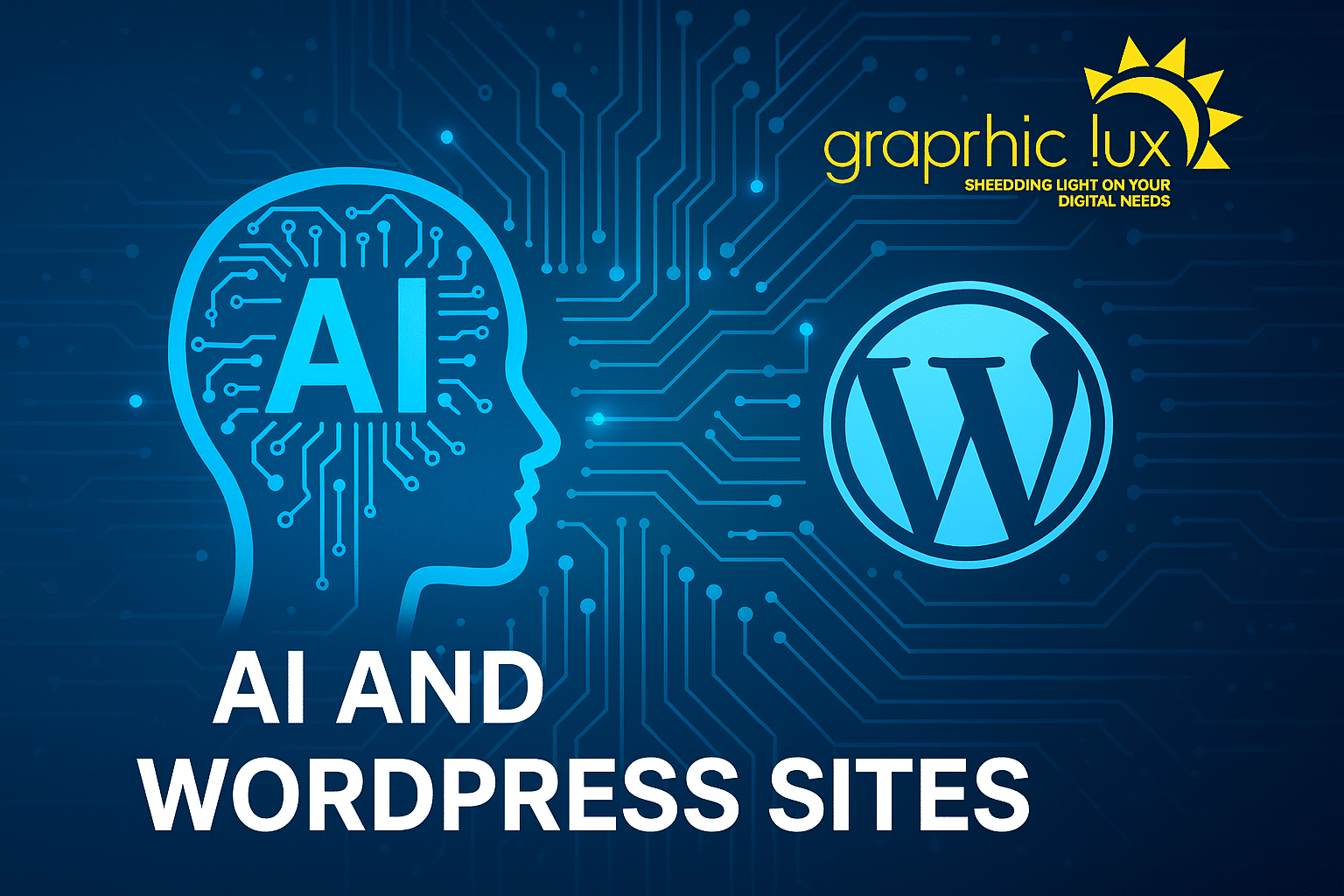How AI Is Quietly Transforming WordPress Sites
When someone mentions “AI on a WordPress site,” it’s easy to imagine a chatbot popping up or automated blog writing. While those are real, there’s a subtler evolution happening; namely, AI is enhancing how visitors experience websites and how owners manage them behind the scenes. At Graphic Lux, we’ve been watching this shift unfold, and it’s worth a deeper exploration.
Personalization That Feels Like It’s Reading Your Mind
Remember visiting a site where every page felt like it was tailored just for you? That’s AI in action. WordPress site plugins powered by machine learning can now analyze visitor behavior. One way is by detecting which pages users linger on and which products they scroll past. The website can then dynamically suggest other content or products they might like.
This kind of personalization goes beyond static “related posts”; it learns from user patterns in real time, adapting just as each person interacts. Studies show marketers are seeing measurable lifts thanks to personalization. For businesses, this isn’t fluff. It means higher user engagement, more time on site, and ultimately more conversions.
Smarter WordPress Site Content Creation & Optimization
AI doesn’t replace writers. It empowers them. Tools integrating GPT‑4 and similar models can assist with drafting, rewriting, or optimizing content for SEO directly in the WordPress editor.
Imagine starting a blog post and having AI suggest headings based on current search trends, or help rewrite a paragraph for clarity, all without leaving your site. This cuts time and effort, and aligns with strategies we often use at Graphic Lux to maintain client blogs. These integrations echo how AI content tools (like Yoast and WordPress plugins) offer real-time optimization prompts. The result? Content that checks SEO, accessibility, and readability boxes, right as you write.
Security That Watches for Threats 24/7
WordPress site security plugins have long tackled basics like brute force attacks and malware scans. But now AI-fueled tools are taking it further. They analyze traffic patterns, flag anomalies, detect suspicious login behavior, and even block emerging threats intelligently.
Graphic Lux always emphasizes security as part of our Care Plans, but AI adds another layer, akin to a security guard who never sleeps. Tools like AI‑enhanced Wordfence and Sucuri learn what “normal” looks like on your site, then act faster and more precisely when things go off-script.
Insights From Analytics That Aren’t Just Numbers
Traditional analytics give you page views and bounce rates. With AI, those figures start telling deeper stories, such as predicting which users are poised to convert or identifying underperforming pages before they tank.
For example, AI‑powered Google Analytics 4 (GA4) leverages machine learning to surface trends and suggest optimizations. At Graphic Lux, that means we don’t just send clients raw data—we deliver insights. The analytics tell us not just which pages are busy, but what drives visitors to action, helping refine design, content, or SEO strategy quickly.
Creating More Inclusive, Accessible Sites by Default
Accessibility isn’t optional. It’s essential. AI is making inclusive design easier by automatically generating alt text for images, providing audio transcription, or even translating site content on the fly.
Tech like Google Cloud Vision can analyze images and output rich, screen-reader-friendly descriptions. Other AI tools integrate with WordPress site to check content for accessibility issues. By embedding these into regular site updates, savvy marketers meet WCAG standards—and do it seamlessly over time.
Bringing It All Together: Practical AI Strategy for Your WordPress Site
So what does this all mean in practice? Let’s walk through how a local business might use AI to elevate their site, all without a futuristic budget.
1. Start with AI personalization plugins: install one that gently suggests relevant posts or products based on visitor behavior. No need for custom code. Just configure rules and let the tool learn over time.
2. Next, use AI writing assistants: enable suggestions in your WordPress site editor or content plugin. Let AI help with SEO keywords, heading structure, or clarity as you draft.
3. Then, upgrade your security: choose an AI‑powered firewall or malware detector that adapts based on your WordPress site’s traffic patterns.
4. On top of that, connect AI analytics like GA4, then review the insights monthly. That way, you know when new pages need more visibility or when a drop in engagement could signal a technical issue.
5. Finally, embed AI accessibility layers: plugins that automate alt text or accessibility checks will help you keep things compliant without manual audits.
Why Graphic Lux Believes in This Approach
Our WordPress Care Packages already include maintenance, backups, updates, and speed optimizations—so integrating AI feels like a natural next step. We aim to ensure your site isn’t just functional, but adaptive.
We don’t believe in gimmicks. Instead, AI should quietly enhance what already works—streamlining workflows, making sites more intuitive, and providing owners with meaningful data without tech overwhelm.
If you’d like to see AI features in action on a live site, check out our case study on WordPress page speed optimization or explore how we integrate SEO and analytics. Then, when you’re ready, we can walk through specific AI tools that fit your site and goals.
Learn More about Your WordPress Site and Explore Further
- Dive deeper into WordPress AI trends via WPBeginner‘s “AI in WordPress” tutorial.
- Explore how Salesforce quantified AI’s impact on personalization.
- Read about AI-powered analytics in GA4 on Google’s official Analytics Help guides.
AI isn’t flashy—it’s thoughtful. On your WordPress site, it’s less sci-fi, more “tech that listens.” And in 2025, that subtle intelligence shows up as smoother user experiences, smarter content, and defensible growth paths. If you’re curious about making AI a quiet ally in your digital toolkit, let’s talk. We are ready when you are.



